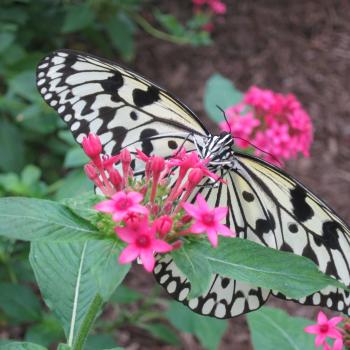Butterfly Gardening in Arkansas
Butterflies are a welcome visitor to any Arkansas garden. To attract butterflies, gardeners are planting all types of blooming plants, in the hopes that butterflies will flock to their garden. While many flowering plants will entice butterflies to your garden, to increase diversity, consider adding plants that serve as food for the caterpillars. A butterfly garden can be as small as a few containers of plants, or as large as the yard you have.
The basic requirements for a butterfly and pollinator-friendly garden are:
- Sun
- Nectar source plants
- Larval host plants
- A pesticide-free environment

While many gardeners like butterflies, most are not as enamored with the caterpillars–because they do eat holes in the leaves of the plants, and sometimes appear to be consuming the whole plant. While it may not be totally aesthetically pleasing, that is their role in the chain of life for butterflies, and it really doesn't hurt the host plants.
If you want butterflies, then you also need caterpillars, and they won't eat every plant in your yard—they have their specific host requirements.
Some of the most popular food sources for a wide range of butterflies include members
of the parsley family, including parsley, fennel, dill and Queen Anne's Lace.
The milkweed family is another excellent food source, including the showy butterfly
weed– with both the native orange (Asclepias tuberosa) and the tropical ones; along
with the perennial passionvine and pipevine, and woody plants such as spice bush,
hackberry, apples and cherry trees.
Nectar plants are often more showy and fun to have in the garden, but you need both types to satisfy your butterflies.
Some common nectar plants include:
- buddleia or butterfly bush
- butterfly weed
- lantana
- honeysuckle
- coreopsis
Butterflies are a wonderful study of metamorphosis. As the emerging caterpillar comes
out of the egg, which has been cleverly laid on a host plant, the larvae eats a large
part of its shell before starting to feed on the plant itself. Caterpillars are very
limited in their diet; many species will only eat the leaves of a single type of plant.
They usually eat only the plant that their mother carefully chose to lay their egg
on. The larvae are eating machines, actually outgrowing their bodies five times. Then
the caterpillar pupates, covering itself with a protective shell, and metamorphosing
into an adult butterfly or moth.
Threats to Butterflies
Despite the number of butterflies we see, there are dangers at all stages of the butterflies development. Insects and birds can eat the eggs, and parasites can also destroy them in the egg stage. The larvae have even more problems to deal with, from birds to wasps and other bugs, to spiders. They also have to fend off disease problems, and avoid pesticide sprays. And even as adult butterflies, they aren't immune to being attacked by birds or bugs. Yet butterflies can be as crafty as their attackers. They try to hide their eggs on the undersides of leaves. The larvae can have the color or pattern of the plants they are feeding on, helping to camouflage themselves, and some even have false eyes on their backs, or look like bird droppings. The pupal stage or chrysalis can also be masked by looking like a leaf or even a thorn on the host plant.